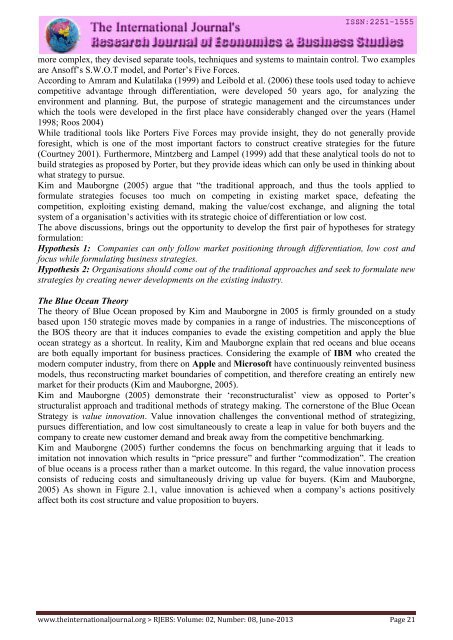Research Journal of Economics & Business Studies - RJEBS - The ...
Research Journal of Economics & Business Studies - RJEBS - The ...
Research Journal of Economics & Business Studies - RJEBS - The ...
- No tags were found...
You also want an ePaper? Increase the reach of your titles
YUMPU automatically turns print PDFs into web optimized ePapers that Google loves.
more complex, they devised separate tools, techniques and systems to maintain control. Two examples<br />
are Ans<strong>of</strong>f’s S.W.O.T model, and Porter’s Five Forces.<br />
According to Amram and Kulatilaka (1999) and Leibold et al. (2006) these tools used today to achieve<br />
competitive advantage through differentiation, were developed 50 years ago, for analyzing the<br />
environment and planning. But, the purpose <strong>of</strong> strategic management and the circumstances under<br />
which the tools were developed in the first place have considerably changed over the years (Hamel<br />
1998; Roos 2004)<br />
While traditional tools like Porters Five Forces may provide insight, they do not generally provide<br />
foresight, which is one <strong>of</strong> the most important factors to construct creative strategies for the future<br />
(Courtney 2001). Furthermore, Mintzberg and Lampel (1999) add that these analytical tools do not to<br />
build strategies as proposed by Porter, but they provide ideas which can only be used in thinking about<br />
what strategy to pursue.<br />
Kim and Mauborgne (2005) argue that “the traditional approach, and thus the tools applied to<br />
formulate strategies focuses too much on competing in existing market space, defeating the<br />
competition, exploiting existing demand, making the value/cost exchange, and aligning the total<br />
system <strong>of</strong> a organisation’s activities with its strategic choice <strong>of</strong> differentiation or low cost.<br />
<strong>The</strong> above discussions, brings out the opportunity to develop the first pair <strong>of</strong> hypotheses for strategy<br />
formulation:<br />
Hypothesis 1: Companies can only follow market positioning through differentiation, low cost and<br />
focus while formulating business strategies.<br />
Hypothesis 2: Organisations should come out <strong>of</strong> the traditional approaches and seek to formulate new<br />
strategies by creating newer developments on the existing industry.<br />
<strong>The</strong> Blue Ocean <strong>The</strong>ory<br />
<strong>The</strong> theory <strong>of</strong> Blue Ocean proposed by Kim and Mauborgne in 2005 is firmly grounded on a study<br />
based upon 150 strategic moves made by companies in a range <strong>of</strong> industries. <strong>The</strong> misconceptions <strong>of</strong><br />
the BOS theory are that it induces companies to evade the existing competition and apply the blue<br />
ocean strategy as a shortcut. In reality, Kim and Mauborgne explain that red oceans and blue oceans<br />
are both equally important for business practices. Considering the example <strong>of</strong> IBM who created the<br />
modern computer industry, from there on Apple and Micros<strong>of</strong>t have continuously reinvented business<br />
models, thus reconstructing market boundaries <strong>of</strong> competition, and therefore creating an entirely new<br />
market for their products (Kim and Mauborgne, 2005).<br />
Kim and Mauborgne (2005) demonstrate their ‘reconstructuralist’ view as opposed to Porter’s<br />
structuralist approach and traditional methods <strong>of</strong> strategy making. <strong>The</strong> cornerstone <strong>of</strong> the Blue Ocean<br />
Strategy is value innovation. Value innovation challenges the conventional method <strong>of</strong> strategizing,<br />
pursues differentiation, and low cost simultaneously to create a leap in value for both buyers and the<br />
company to create new customer demand and break away from the competitive benchmarking.<br />
Kim and Mauborgne (2005) further condemns the focus on benchmarking arguing that it leads to<br />
imitation not innovation which results in “price pressure” and further “commodization”. <strong>The</strong> creation<br />
<strong>of</strong> blue oceans is a process rather than a market outcome. In this regard, the value innovation process<br />
consists <strong>of</strong> reducing costs and simultaneously driving up value for buyers. (Kim and Mauborgne,<br />
2005) As shown in Figure 2.1, value innovation is achieved when a company’s actions positively<br />
affect both its cost structure and value proposition to buyers.<br />
www.theinternationaljournal.org > <strong>RJEBS</strong>: Volume: 02, Number: 08, June-2013 Page 21

















